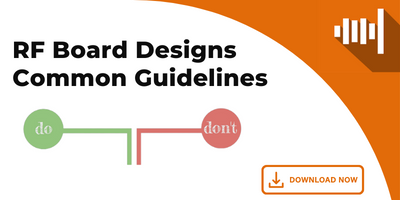
Whether it’s a fancy new gaming PC, an HDTV, or a 5G phone, all of them make use of printed circuit boards (PCBs). A technological innovation dating back to the 1940s, the circuit board is part of what makes all modern electronics possible, and radio frequency (RF) products are no exception.
Following best practices when designing a PCB is one the first steps to building an RF system that performs well. This article will offer some basic tips for good RF circuit board design and common mistakes that engineers should avoid.
Power Planes
The way that power planes are laid out across a PCB is very important. One mistake that can cause a lot of problems is to design your RF board with the power planes around the edges of the card. This can have the undesirable effect of causing a lot of parasitic radiation. It’s better to run them between two ground planes to decouple the ground and supply.
Layers, Lines, & Traces
One of the first decisions you’ll need to make when designing an RF PCB is the number of layers you want to use. Single-layer circuit boards simply won’t work for RF design because the traces require a good ground reference, which requires a coplanar stripline. A 2-layer RF board design is workable for some applications, but the space for DC power is limited.
Generally, 4-layer boards are optimal for most RF PCB designs, as they facilitate distributed RF decoupling of a DC power plane, with 2 layers of mostly ground plane separating them. 4-layer PCBs also allow for easier use of microstrip and stripline transmission lines. (If using a 2-layer RF board design, make sure that the total board thickness is no more than 30 mils, otherwise the line trace will need to be a little too wide for this size.)
Related: 7 Key Factors of Crystal Oscillator Circuit Design
Circuit Loops & Decoupling
The location of decoupling components on an RF circuit board is very important. As much as possible, you should try to minimize captive coupling and put decoupling caps to ground near the pin to reduce current loops. You also need to make sure that every port or pin is decoupled to ground through its own dedicated via.
Parasitics & Thermal Relief
Circuit board parasitics must also be taken into account with RF board design. The term “parasitics” applies to any physical trait of the circuit board that can influence how well it performs. The higher the radio frequencies you’re working with, the more damaging parasitic effects can be.
There are several design techniques you can use for dealing with parasitic effects. One of these is to avoid making hard, sharp changes (think right angles) in your trace width, as this can negatively impact the RF signal. Imagine a pipe transporting water or some other liquid. If the pipe took a hard 90-degree turn, this would slow down the flow of the liquid, since it has to abruptly change direction. The same thing happens with an RF signal when the board has traces with right angle turns. It’s much better to go with smoother, more curved and gradual turns in the traces.
For thermal relief, making use of thermal relief pads can be helpful. It’s best to connect the pad to component side ground connections. These should be connected the primary ground plane layer by multiple parallel thermal vias.
Related: 4 Key Questions to Ask to Find the Perfect Crystal Oscillator for Your Design
Achieve More with Bliley on Board
At Bliley, we have nearly a century of experience in RF technology. We're committed not only to manufacturing the best oscillators and frequency control devices in the universe, but also to providing helpful advice for RF engineers.
RF PCB design is complex and important work, and we’ve only just scratched the surface. For a quick visual reference guide of the dos and don’ts of designing RF boards, check out our free Common Guidelines for RF Board Design infographic.






